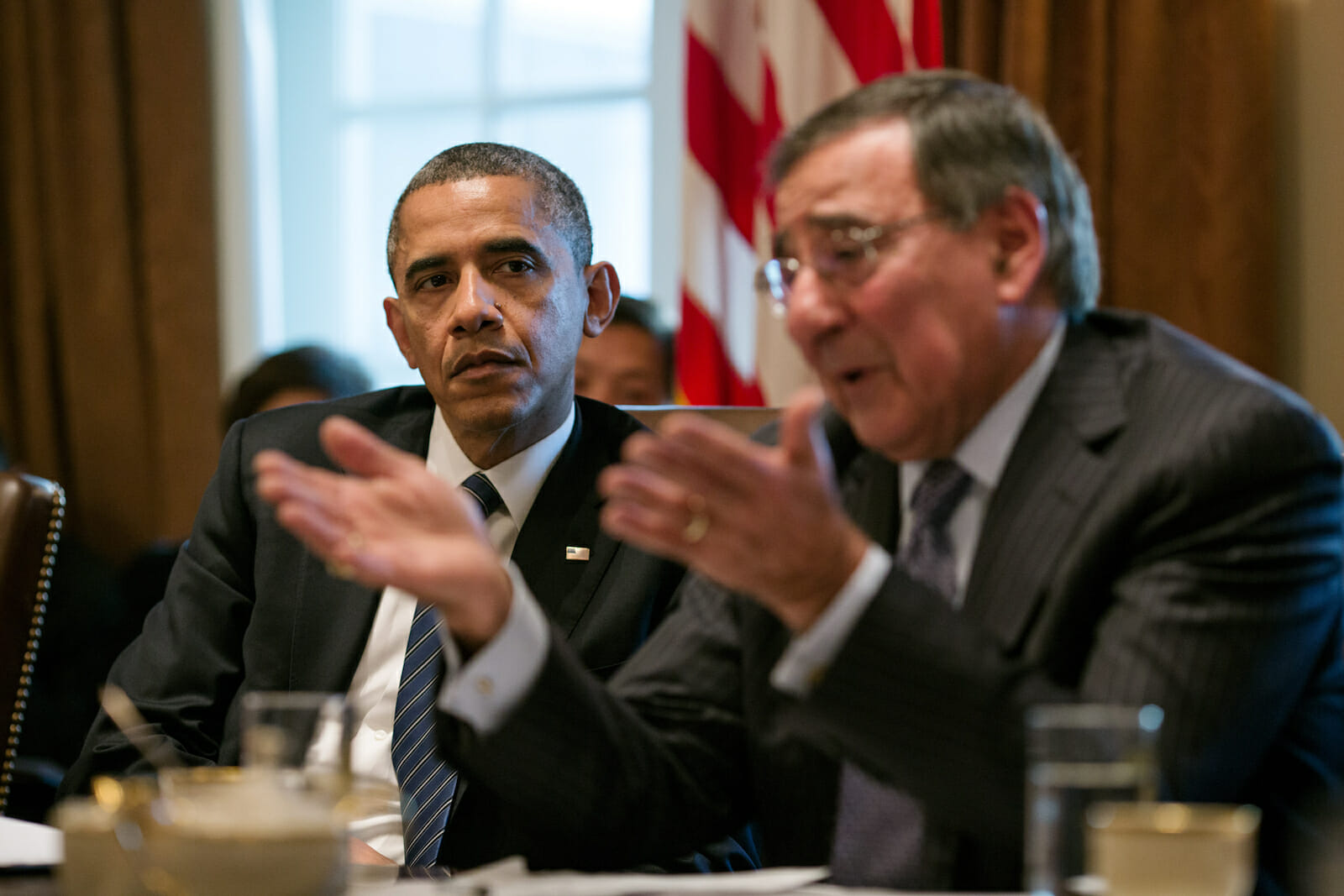
Can the Pentagon Make Do with Less?
The United States spends more on its military than the defense budgets of Russia, China, and Europe. During and after the Cold War, the U.S. military established military bases around the globe at significant financial costs. While some of this presence is strategic, like the military bases in South Korea and Japan, some argue that a continued military presence in Europe does not make tactical or strategic sense given Europe’s ability to pay for its own defense. “Immediately after World War II,” write Reps. Barney Frank (D-MA) and Ron Paul (R-TX), “America took on the responsibility of protecting virtually every country that asked for it. Sixty-five years later, we continue to play that role long after there is any justification for it, and currently, American military spending makes up approximately 44% of all such expenditures worldwide.”
In 2010, U.S. military expenditures were $698 billion, China 532 billion Yuan ($78 billion) and Russia 1782 billion rubles ($58.7 billion). Alarming U.S. strategists are the increased Chinese and Russian military expenditures. However, the significance is that both states have spent more dollars recently primarily due to military upgrades and to improve their competitiveness vis-à-vis the United States. According to the Kremlin, over the next couple of years, Russian military spending will increase. “Defense spending in 2010 was 2.6% [of GDP], in 2011 the volume of funding will be 2.9%, in 2012 3% and then 3.2%,” said Anton Siluanov, Russia’s Deputy Finance Minister, to the Russian parliament. “World military expenditure in 2010 reached $1630 billion, representing 2.6 percent of global gross domestic product (GDP) or $236 for each person. Spending was 1.3 percent higher in real terms than in 2009 and 50 percent higher than in 2001.
The growth in 2010 was almost entirely due to the United States; military spending in the rest of the world increased by just 0.1 percent. Over the period 2001–10, US military spending increased by 81 percent, compared to 32 percent in the rest of the world,” according to Stockholm International Peace Research Institute.
While some countries and regions have bolstered their military expenditures over the U.S., the U.S. military in qualitative terms is still the most powerful in the world. While South America witnessed an increase in military expenditures by 5.8 percent and Africa by 5.2 percent some regions saw a decline as in the case of Europe and Asia because of the global economic recession.
While American policymakers and military strategists raised eyebrows over the proposed French sale of Mistral class helicopter carriers to Russia, the purchase is far from certain given the sensitivities of the talks between Paris and the Kremlin. The U.S. Navy operates 11 nuclear power aircraft carriers which is unmatched by any other country’s navy. Additionally, the U.S. Navy operates 57 submarines, nuclear and otherwise, also unmatched. The same can be said for U.S. air superiority and land-based capabilities. While other nations have larger land armies, as in the case of North Korea, they are untrained and ill-equipped.
With the debate in Washington about the debt limit and overall government spending, both Republicans and Democrats are targeting the once-sacrosanct defense budget as an area to achieve billions and perhaps a trillion dollars in savings. Whether President Obama and the Speaker of the House John Boehner pursue a “grand bargain” or the White House and the Senate put forth the Gang of Six proposal to negotiate a lifting of the debt ceiling while at the same time slashing trillions in domestic spending and reshaping long-held Democrat priorities like Medicare and Social Security, defense spending has come under the microscope.

With the possibility that an aircraft carrier group could be eliminated and a whole host of other weapons programs, the Pentagon realizes that its days of unquestioned budget requests are now being questioned. In April the Obama administration acknowledged that $400 billion would be eliminated but the possibility that an additional $400 billion in savings over 12 years might be sought as part of a “grand bargain” between Obama and Boehner has military planners concerned as they scramble to find more savings. “We’re doing due diligence on that,” said Gen. James E. Cartwright, vice chairman of the Joint Chiefs of Staff. “But the reality is you’re most worried about a deeper cut. Is there another $400 billion beyond the first $400 billion?”
While former Defense Secretary Robert Gates was well known for his advocacy of canceling unneeded weapons programs like the F-22 Raptor, his replacement, Leon Panetta, is likely to sign off on any agreement due to his experience on Capitol Hill and in the Clinton administration as its OMB director. “Panetta will have to begin his Pentagon service by addressing the department’s overstretched budget. The 73-year-old boasts vast experience in the financial sector. At one time, he was head of the House’s Appropriations Committee. He also ran the White House Office of Management and Budget under Clinton. Hence, he should be more than familiar with the inner budgetary workings of the U.S. government,” writes RIA Novosti’s Andrei Fedyashin. “The Pentagon’s budget is first on the chopping block. Gates managed to reduce the department’s spending by $400 billion for the next decade, but Obama wants to at least double that figure. Panetta is clearly the right man for the job at a time that calls for tough fiscal decisions.”
Panetta’s predecessor, Robert Gates, to his credit did order the Pentagon to identify savings that could be made in the area of $100 billion but this money was simply put back into other weapons programs. And under pressure to pursue actual savings for U.S. taxpayers he again ordered the Pentagon to identify roughly $78 billion in cuts. With Democrats and now importantly Republicans willing to see the Pentagon budget cut by as much as $800 billion or more over the next decade, the larger question is can the Pentagon do with less? Even if Pentagon cuts near the $1 trillion dollar mark as Sen. Tom Coburn (R-OK) recently suggested, this ballpark amount would pale in comparison to the cuts made at the Pentagon toward the end of the Cold War of 36 percent from 1985 to 1998.
Many defense experts like Admiral Michael Mullen and the Brookings Institution’s Michael O’Hanlon and Peter W. Singer argue that if America’s large budget deficit is not dealt with appropriately, potentially America’s long-term security could be undermined. “The nation’s problems of economic security are intertwined with national security. If we don’t act on trillion-dollar deficits, we risk the underlying economic bedrock of our long-term defense capability. But defense cuts also add risk to the nation’s security in a time of uncertainty,” O’Hanlon and Singer write in Politico.
As the budget debate moves into the crucial next two weeks before the U.S. defaults on its financial obligations, targeted saving will be made to domestic and defense spending. Congressional leaders and the White House are unlikely to take a meat cleaver to the Pentagon budget but the reality is that some savings will be achieved. While isolationists like Ron Paul of Texas and Vermont’s Bernie Sanders would prefer to see all U.S. commitments abroad ended in the short-term, U.S. military planners must consider long-term commitments past the Afghan and Iraq wars. What to cut, when to cut and how to cut defense spending will be partly based on long-term threat assessments.
Further, policy makers and Mr. Panetta must come to terms with the fact that the DoD has become a bureaucratic juggernaut and savings cannot be achieved at the risk of U.S. service members in Afghanistan or Iraq. Beyond weapons programs like new long-range bombers and new classes of submarines, personnel costs and other related costs are drivers in the expansive Pentagon budget.
“The reason we have a Department of Defense is to break things and kill people,” said Arnold L. Punaro of Punaro Group, LLC. “The problem we have now is that so much of the money is not going to the people who are breaking things and killing people.” The period following 9/11 explains the huge growth at the Pentagon. But as the U.S. commitments in Iraq and Afghanistan end the U.S. military has to recalibrate its priorities and budgetary needs. Additionally, the U.S. has few military rivals necessitating the need for 11 or more aircraft carriers and/or long-range bombers or the need for hundreds of thousands of active duty military personal. Shared sacrifice as expressed by President Obama could be applied to the Pentagon as well.
“This new era will require a different mindset for our government and industry managers and congressional overseers, a generation of whom has grown accustomed to growth [in] the post 9/11 decade to a circumstance in which they could always reach for more money when they encountered a managerial or technical problem or a difficult choice,” said Ashton Carter, the undersecretary of defense for acquisition, technology and logistics. “Those days are gone.”

